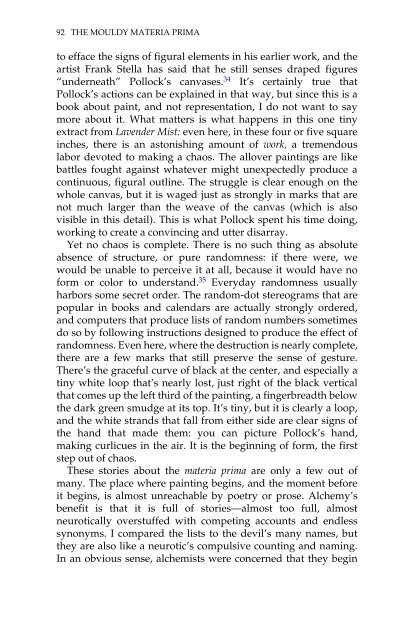What Painting Is: How to Think about Oil Painting ... - Victoria Vesna
What Painting Is: How to Think about Oil Painting ... - Victoria Vesna
What Painting Is: How to Think about Oil Painting ... - Victoria Vesna
You also want an ePaper? Increase the reach of your titles
YUMPU automatically turns print PDFs into web optimized ePapers that Google loves.
92 THE MOULDY MATERIA PRIMA<br />
<strong>to</strong> efface the signs of figural elements in his earlier work, and the<br />
artist Frank Stella has said that he still senses draped figures<br />
“underneath” Pollock’s canvases. 34 It’s certainly true that<br />
Pollock’s actions can be explained in that way, but since this is a<br />
book <strong>about</strong> paint, and not representation, I do not want <strong>to</strong> say<br />
more <strong>about</strong> it. <strong>What</strong> matters is what happens in this one tiny<br />
extract from Lavender Mist: even here, in these four or five square<br />
inches, there is an as<strong>to</strong>nishing amount of work, a tremendous<br />
labor devoted <strong>to</strong> making a chaos. The allover paintings are like<br />
battles fought against whatever might unexpectedly produce a<br />
continuous, figural outline. The struggle is clear enough on the<br />
whole canvas, but it is waged just as strongly in marks that are<br />
not much larger than the weave of the canvas (which is also<br />
visible in this detail). This is what Pollock spent his time doing,<br />
working <strong>to</strong> create a convincing and utter disarray.<br />
Yet no chaos is complete. There is no such thing as absolute<br />
absence of structure, or pure randomness: if there were, we<br />
would be unable <strong>to</strong> perceive it at all, because it would have no<br />
form or color <strong>to</strong> understand. 35 Everyday randomness usually<br />
harbors some secret order. The random-dot stereograms that are<br />
popular in books and calendars are actually strongly ordered,<br />
and computers that produce lists of random numbers sometimes<br />
do so by following instructions designed <strong>to</strong> produce the effect of<br />
randomness. Even here, where the destruction is nearly complete,<br />
there are a few marks that still preserve the sense of gesture.<br />
There’s the graceful curve of black at the center, and especially a<br />
tiny white loop that’s nearly lost, just right of the black vertical<br />
that comes up the left third of the painting, a fingerbreadth below<br />
the dark green smudge at its <strong>to</strong>p. It’s tiny, but it is clearly a loop,<br />
and the white strands that fall from either side are clear signs of<br />
the hand that made them: you can picture Pollock’s hand,<br />
making curlicues in the air. It is the beginning of form, the first<br />
step out of chaos.<br />
These s<strong>to</strong>ries <strong>about</strong> the materia prima are only a few out of<br />
many. The place where painting begins, and the moment before<br />
it begins, is almost unreachable by poetry or prose. Alchemy’s<br />
benefit is that it is full of s<strong>to</strong>ries—almost <strong>to</strong>o full, almost<br />
neurotically overstuffed with competing accounts and endless<br />
synonyms. I compared the lists <strong>to</strong> the devil’s many names, but<br />
they are also like a neurotic’s compulsive counting and naming.<br />
In an obvious sense, alchemists were concerned that they begin


